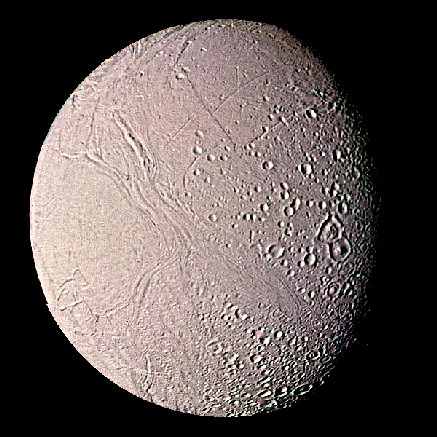

Enceladus:
Enceladus is one of the innermost moons of Saturn. Enceladus reflects almost 100 percent of the sunlight that strikes it.
Enceladus displays several different types of terrain. Parts of Enceladus shows craters no larger than 35 km in diameter. Other areas show regions with no craters indicating major resurfacing events in the geologically recent past. There are fissures, plains, corrugated terrain and other crustal deformations. All of this indicates that that interior of the moon may be liquid today, even though it should have frozen aeons ago.
It is postulated that Enceladus is heated by a tidal mechanism similar to Jupiter's moon Io. It is also perturbed in its orbit by Saturn's gravitational field and by the large neighboring satellites Tethys and Dione. Because Enceladus reflects so much sunlight, the surface temperature is only -201 C (-330 F).
In many ways, the surface of this satellite of Saturn resembles that of Jupiter's Galilean satellite, Ganymede. Enceladus, however, is only one-tenth Ganymede's size. Linear sets of grooves tens of kilometers long traverse the surface and are probably faults resulting from deformation of the crust. The uncratered regions are geologically young and suggest that Enceladus has experienced a period of relatively recent internal melting. The rims of several craters near the lower center of the picture have been flooded by the smooth terrain.